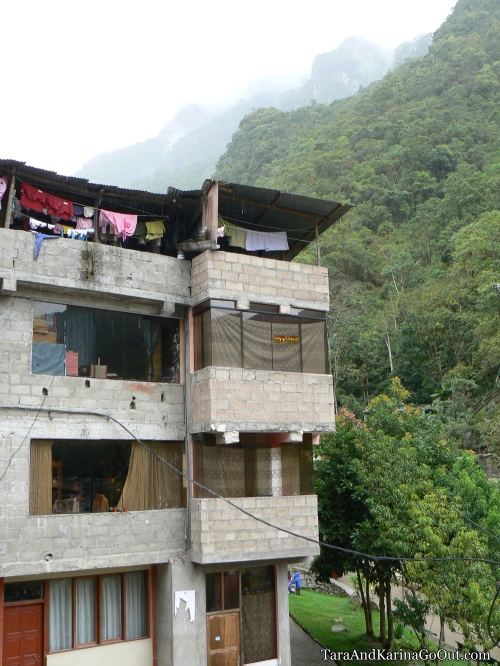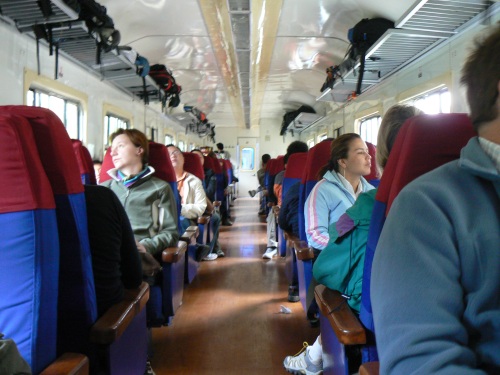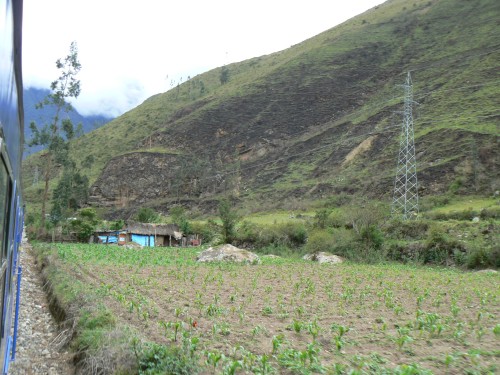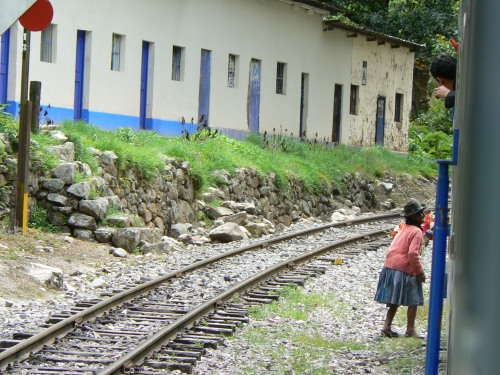 The view from an open-air hostel in Aguas Calientes, Peru, overlooked an apartment complex and a steep incline up the nearby mountain.
The view from an open-air hostel in Aguas Calientes, Peru, overlooked an apartment complex and a steep incline up the nearby mountain.
Click to read more on the train to Aguas Calientes from Cusco, or learn about the climb up Machu Picchu.
–Tara
 The view from an open-air hostel in Aguas Calientes, Peru, overlooked an apartment complex and a steep incline up the nearby mountain.
The view from an open-air hostel in Aguas Calientes, Peru, overlooked an apartment complex and a steep incline up the nearby mountain.
Click to read more on the train to Aguas Calientes from Cusco, or learn about the climb up Machu Picchu.
–Tara
Posted in Shot of the Week
Tagged Aguas Calientes, Machu Picchu, Shot of the Week, Tara
Half the magic of Machu Picchu is getting there. While most would refer to the Inca Trail with that statement, I say look to the train!

The less affordable tourist train service starts at roughly US$50 each way on PeruRail. If you’re on a budget (and a more flexible timeframe) there’s also an incredibly unreliable local train that runs between Cusco and Aguas Calientes on the older train tracks. Be sure to check weather conditions and train schedules in the month before you leave and the day before you leave, as train service is often discontinued for months at a time without much notice.
The local was undergoing extensive repairs (read: no one moved blockage from the tracks for months) but we didn’t mind spending a little extra cash for the comfortable seats, shorter travel time and prettier route.
Schedule your four-hour train ride for the afternoon before your Machu Picchu visit and reserve space in a hostel in Aguas Calientes for the night you arrive. If you reserve tickets at least a few months before your trip, you won’t have to worry about a sold-out train. However, if PeruRail is fully booked from Cusco to Aguas Calientes by the time you make your reservation, just book from nearby Ollantaytambo, the first stop on the train from Cusco to Aguas, where many passengers will get off to see ruins (and make room for you!).

When the train stops to pick up cargo, mail, and additional passengers, some enterprising locals would walk beside the train cars selling homemade hot meals, breads, snacks and even flowers.

Sunrise over Machu Picchu cannot be missed, and you’ll need your beauty rest for that 5 a.m. bus departure to make the 5:30 a.m. daybreak. (If you want to go the lazy route, the best part of the sunrise happens between 7 and 7:30 a.m. so you can catch a slightly later bus up the mountain. However, the lines of tourists will be so long you may just have to leave at the same time!) Grab the bus at the Machu Picchu Pueblo Train Station at the center of the city.
From there, you’ve got nowhere to go but up.
–Tara for TKGO
For additional trip planning help, I recommend PeruTreks.com’s helpful maps and information. Or, continue your trip to Machu Picchu with TKGO!
Posted in Active, Art/Architecture
Tagged Aguas Calientes, Cusco, Machu Picchu, Peru, Tara
Some say there’s no difference between hiking and walking. I say no one “hikes” to the top of Machu Picchu — you hang on with all fours.
The saga began with a three-hour train ride from Cusco to Aguas Calientes, and a bus from our hostel in Aguas Calientes directly up the mountain to Machu Picchu. Crashes are common because everything’s old — the buses and the pavement on the hairpin turns. (If you’re wondering why we didn’t take the Inca Trail, my friend Ashley and I opted to save the two weeks of pain in favor of time at Rio de Janeiro’s beaches. Can’t beat that.) But after you get off the bus, heaving and crying, the view at the top will brighten your mood.
It rained off and on while my friend Ashley and I explored the ruins, so the guides handed out colorful ponchos which made it easy for us to pick out tourist hot spots. Mostly, visitors clung to the outskirts of the complex, peering over the edges of the mountain at the steps leading up to it or some of the small outposts and houses sitting on the outcrops.
Though the fog rarely lifts completely from the mountains at this altitude, pockets will open that reveal pieces of the view you’re missing. The fog will sit in the valleys below, and the Andes mountains become looming shadows like ships at sea.
The architecture is stunning, as can be expected. The Incans used three types of stone construction depending on the use of the building. The more difficult and airtight design takes far longer to build and is used for religious or holy buildings. Another type is used on the wealthy families’ homes and other public buildings, and the final on peasants’ homes. Below is an example of the second type, where stones are slightly shaped to fit one another but are not exact, as on religious buildings.
The windows slant inward toward the top, making them resilient against bad weather for over 600 years.
Some places you see when you travel require a photo album to remember the details, but Machu Picchu is not one of them. I hope you enjoy these snapshots, but they can’t do justice to the feeling of sitting in the fog at almost 8,000 feet above sea level in a city built by an extinct empire. I promise, the bus ride is worth it.
–Tara for TKGO
Posted in Active, Art/Architecture
Tagged Aguas Calientes, Andes, Cusco, Inca, Incas, Machu Picchu, Peru, Tara, The Lost City, UNESCO World Heritage Site